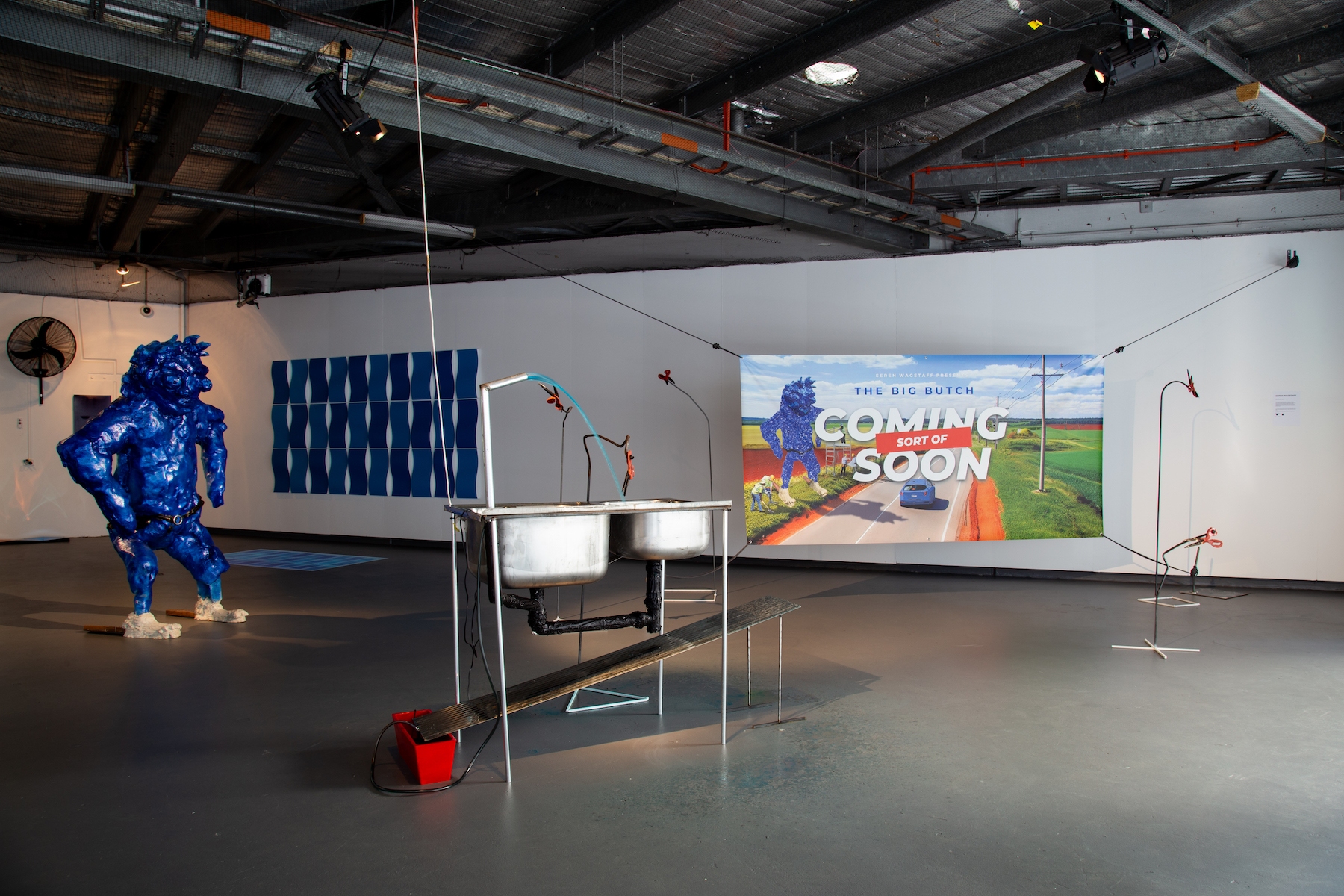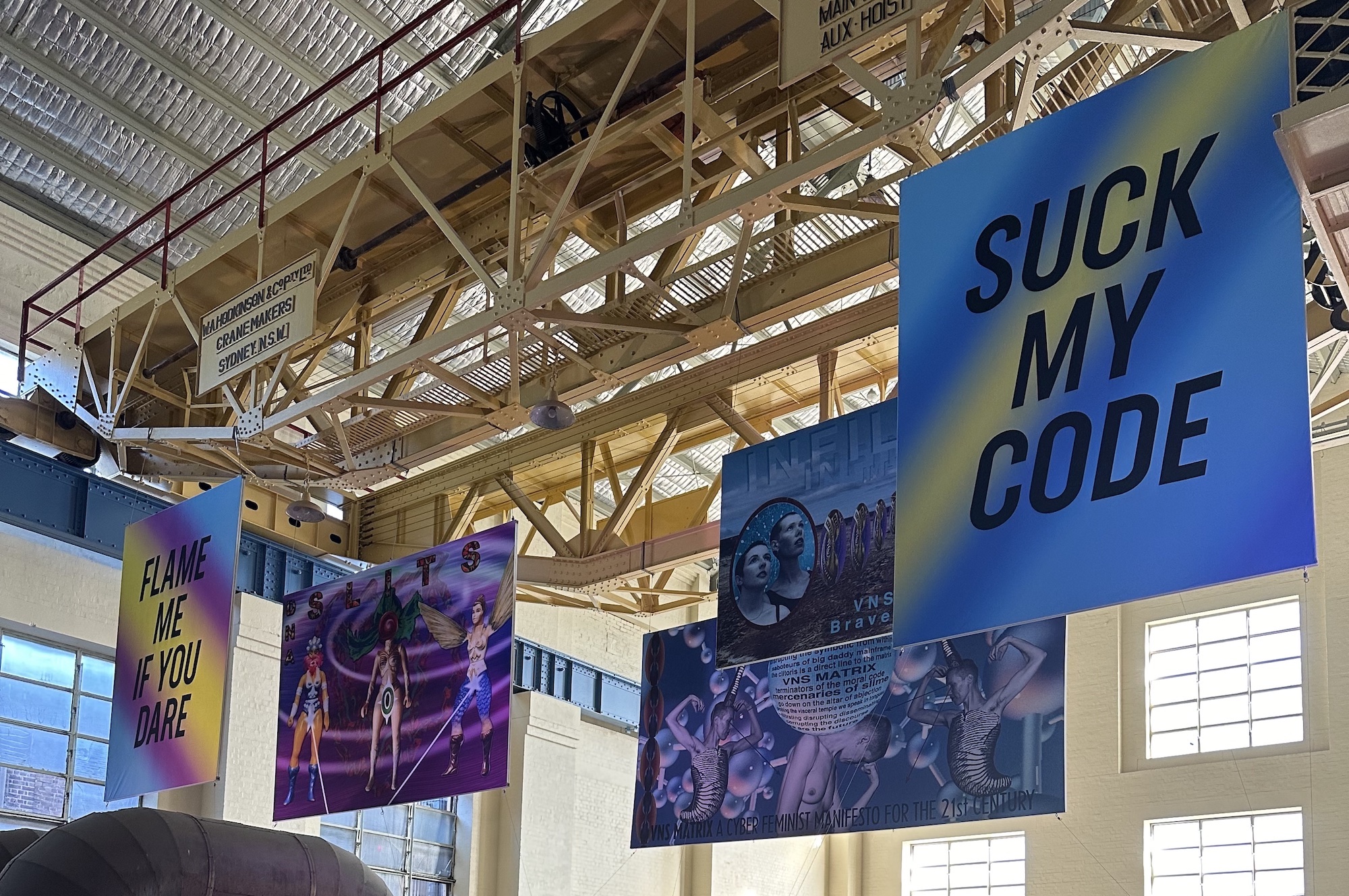Each year, QCA’s oversized undergraduate exhibition sprawls across its South Bank campus requiring sturdy walking shoes, determination, and—more often than not—a second visit. This year’s show correlates with many expectations: painting continues to dominate in terms of footprint just as drawing continues to dwindle; printmaking, photography, and J&SO students (jewellery and small objects) worked neatly within their given media; and CAIA (Contemporary Australian Indigenous Art) boasted sales, with purchasers anticipating this year’s single graduate, Arabella Walker, will catapult into the emerging art scene like recent leavers including Kyra Mancktelow (Telstra Emerging Artist 2022), Dylan Mooney (represented by N.Smith Gallery alongside Mancktelow), and Dylan Sarra (represented by Mitchell Fine Arts). It’s the difference of this year’s show to last, however, that was the leading topic of conversation, with Sculpture and Expanded Practice transforming within the space of 12 months from desperately underdeveloped and poorly hung (prompting this critic to ask: ‘where was the teacher?’) to spectacular. It’s here in the Sculpture studio that we start.
A peculiar, four-sided wooden cabinet—raised on wheeled legs and made immobile by placing one of those legs within a hand-crafted ceramic boot—encases four television screens. Within each screen the artist, Joseph Botica, performs compelling routines. He moves his body to the angles of a protractor, teeters in high heels, vogues, stretches yoga-like, and playfully fights with his own digital image, which shifts around the screen within a smaller square again, equally reminiscent of early Windows desktop glitches, the frenetic digital energy of Solitaire’s bouncing victory screen, and Mortal Kombat’s command to ‘finish him.’ Botica’s highly-developed visual language continues in skewed photographic self-portraits and an installation of additional shoes, cleverly animated via spindly wires that sketch out a three-legged figure topped with a flop of blonde hair. What’s striking about Botica’s presentation is both his ability to roam across multiple media (performance, installation, photography, ceramics) with a cohesive voice and his ability to swivel the navel-gazing tendency of less-developed identity-politics based practices outward, expansively drawing from such diverse sources as da Vinci’s Vitruvian man to web-cam culture to present works that feel equally fresh and rooted in multiple, rhizomatic, histories.
Botica’s work is flanked by Gavan Smith’s Slippery Dip and Seren Wagstaff’s Butch Fountain. Smith presents the most glamorous of the three: bedazzled ceramic bananas in yellow, black, and pink delicately spin atop assorted packing pallets, calling for high-end shopping spotlights and discrete price tags. By contrast, Wagstaff leans toward chaos and (faux) mess. In a towering, misshapen, and brilliant-blue figure; complete with bulging bug-eyes, dripping jockstrap, and exposed concrete feet; Wagstaff imagines an alternative roadside tourist attraction. Queer vocabularies, diversely articulated as unbalanced, distorted, and unfinished forms; performative and sexualised bodies; draw Botica, Smith, and Wagstaff together. In turn, the threesome make the highly-unusual argument (within the context of a grad show) of the vital role that friends, peers, and collaborators play in developing artistic practice. Indeed the entirety of the Sculpture cohort is strong, with the luscious pink folds of Caitlin Fraser and strange creatures of Bowie Dunn and Gabrielle Kelly also pricking attention.
Within Print and J&SO, smaller and quieter works caught my eye. Alethea Richter grappled with the overwhelm of digital technology in subtle abstract prints. Abi Billin unfolded her body from 3-dimensional into 2-dimensional print replete with the fine textures of hair, pores, and wrinkles. Nadya Wilson wrapped a dreamy automatic poem of copper wire around the corner of a gallery, luring us along the wall as we read.
In Photography, two artists stepped away from the wall to great effect. Therese Morgan’s work presented lush landscapes on slim screens, each perched atop great plinths made from raw tree stumps. Gigi Wallace stepped further still. Flavours of the Orient pieces together a room from assorted Asian supermarket and takeaway plastic bags. Within their curtained space sits a makeshift dining room of dirtied chopsticks, folding table, and red stool. Finally, we watch the artist eating mukbang-style, gorging on unknown dishes. The film has been bathed in this same food, introducing organic glitches across its surface, transformed into a stop-start animation, colour saturated, and projected onto the plastic-bag-wall. Finally, a strangely appealing-repugnant ASMR soundtrack plays through headphones placed on the table, heightening the sounds of Wallace’s eating. By pushing well-beyond the four-sided frame of photography, Wallace thinks through the medium’s materiality and grapples with stereotypes of gender and race.
Finally Painting held all manner of interest, including: Jessica Brunetto’s textiles-as-canvases, Ursula Kajewski’s paper-pulp textures, Alisha Kitto’s labour-intense abstraction, Col Mac’s ghost stories, Doug McNeil’s accomplished landscapes, Indya Pearce’s fleshy investigations, Jude Reid’s boxing figures, Toyah Robinson’s distorted perspective, and Georgia Southam-Sharp’s seamless collages. Amongst this cohort, one work of pink breasts flung to the ceiling, boneless arm swung overhead, and legs positioned contrapposto especially stood out. Working on roughly-collaged textile surfaces, the most interesting swaying delicately on long chains hung from the ceiling, Patricia Malt borrows her painterly language from the Angry Penguins to create wild, gritty, and captivating images of women. Both Malt’s figures and her gestures evoke a sense of unleashed emotion and—like so many of her cohort—deserve further investigation.
Looking to the exceptional quality of work showcased the following week, in this years’ QCA Honours show, I’m eager to see how this years’ cohort develop their practices, next year and beyond.
Expanded Lemonade coverage of 2023 graduate exhibitions was kindly made possible by Lemonade’s Patreons and generous contributions from Alex Baxter, Amanda Bennetts, Kylie Harries, Lynn Hughes, Kit Kriewaldt, Pippa Macgill, Merilyn & Steve Mayhew, JM Orme, Alethea Richter, Monica Rohan, Adrian Smith, Gavin Smith, Leisa Turner, Hannah Williamson, Nadya Wilson.
Lemonade is continuing to fundraise for three further reviews. Become a Patreon or email editor @ lemonadeletters.com.au to support this unique coverage of Queensland’s emerging artists.
Louise R Mayhew is an Australian Feminist Art Historian and the Founding Editor of Lemonade.










